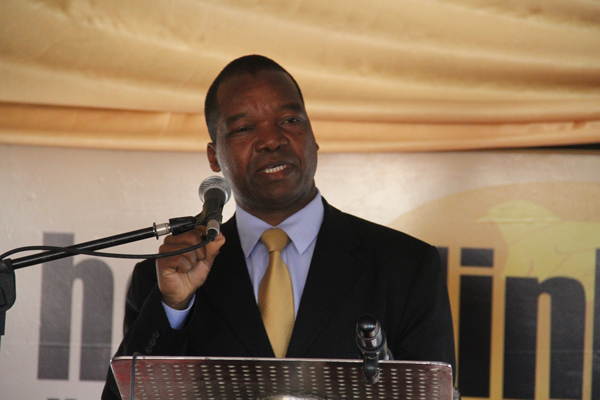
The use of plastic money will remain the preferred short-term strategy for the Reserve Bank of Zimbabwe (RBZ) in dealing with the cash shortages that worsen every month end, Reserve Bank of Zimbabwe governor John Mangudya has said.
BY TATIRA ZWINOIRA & MTHANDAZO NYONI
On average, RBZ imports $20 million in hard cash per month from the United States, a figure that cannot sustain the demand for the US$ in the country.
Recently, the central bank was considering, among a host of other short-term strategies, the importation of the South African rand and euros to support the multicurrency system and reduce the demand for the dollar.
However, Mangudya told Standardbusiness that importing other currencies could only be done based on the demand for that particular currency.
He said such propositions had for now been set aside as the point of sales (POS) transactions had shown a remarkable increase in volumes week by week.
“We have seen significant growth in POS transactions on a week-by-week basis,” Mangudya said.
“People are using this platform because it allows them to continue using dollars.
- Chamisa under fire over US$120K donation
- Mavhunga puts DeMbare into Chibuku quarterfinals
- Pension funds bet on Cabora Bassa oilfields
- Councils defy govt fire tender directive
Keep Reading
“Any talk of the importation of other currencies would be in addition to the United States dollar, but will only be dependent on the demand for that currency from the market itself,” Mangudya said.
“We have noticed that the market can respond negatively and as such, we will not be looking at the importation of rands or euros without proper consultations with stakeholders.
“The market is very volatile at the moment as evidenced by the response to the bond note facility, so we do not want to pressure the market.
“We are having a serious problem with high imports and low exports, so that needs to be addressed.”
Mangudya said the RBZ would instead work on improving POS transactions in the country through increasing the machines on the market.
The aggressive push for the use of plastic money comes on the back of the high demand for cash, with queues evident at banks such as CABS, FBC and POSB across the central business district as civil servants withdraw their July salaries.
The queues are a constant reminder that despite the increase in the use of plastic money, the demand for cash will still be there.
European Union ambassador to Zimbabwe Phillipe Van Damme said the country had a multi-currency regime including euros and the availability of the currency would be dependent on nostro accounts cover.
“There is nothing abnormal in this type of monetary transactions although most euro transactions so far are through inter-bank wire transfers to cover international trade transactions,” he said.
“To my knowledge, there is extremely limited demand for cash in euro. Access to euros is subject to same constraints as other hard currencies and need for nostro account cover.” The dollar has been the currency of choice in the multicurrency basket introduced in 2009 to stem hyperinflation.
The basket initially had the British pound, Botswana pula, euro and the dollar. It was later expanded to include the Australian dollar, Indian rupee, Japanese yen and Chinese yuan.
Statistics released by RBZ in May showed that the currency utilisation levels of the US$ had risen to 95% from 49% in 2009, increasing the demand for the greenback and elbowing out other currencies in the basket.
The strengthening of the dollar against other currencies has made it a currency of choice, with Finance minister Patrick Chinamasa equating Zimbabwe to a fishing pond for the greenback.
Availability of currencies is largely linked to the external trade of the country.
In 2015, the United States Census Bureau reported imports from Zimbabwe amounted to $67,2 million. Zimbabwe’s exports to South Africa were estimated to be about $2,3 billion that same year.
Since the central bank slashed POS transactions costs to $0,10 for any amount up to $10 and $0,45 for those above it, the average week on week increase in the use of plastic money has become the main strategy for dealing with the cash crisis.
Chinamasa said last week that only “10% of deposits should be used for cash transactions while 90% should go towards electronic”.
Confederation of Zimbabwe Retailers president, Denford Mutashu said as long as there was demand for the currencies, his organisation did not see any challenges with the importation of any currency.
“In any case, those currencies just like the United States dollar, are part of the basket of currencies introduced by the government in 2009 to curtail hyperinflation and arrest economic decline,” he said.
“What matters to the retailer mostly is that the customer has the capacity to complete a transaction using any legal medium of exchange,” Mutashu said.
“We actually hope that solving the liquidity challenges will further stimulate demand which has been buoyed by the high acceptance of plastic money currently.”
Mangudya last week said payments through the electronic transaction system had shot to $5,5 billion this month from $4,1 billion achieved in January.
The central bank chief said the increase in the use of plastic money stemmed from measures the bank introduced which had started bearing positive results.
“If we do some analysis of what is happening now we will find that electronic payment systems have gone up. So we are thanking Zimbabweans for a good response to the policy measures,” he said.
“Point of sale machines are working in all the companies, sales are going up in proportionate to the cash sales.”











